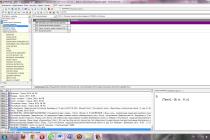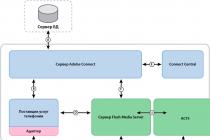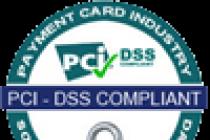Review the general setup process, architecture, data flows, telephony adapters, and edge servers before installing Adobe Connect.
Technical overview for the Adobe Connect system
The Adobe Connect installation consists of several components, depending on the user's selection on the installer screen: Adobe Connect Central Application Server, Adobe AEM, Adobe Media Server, Adobe Connect, Adobe Media Gateway (for Universal Voice), Database, Adobe Connect Telephony Service, and Adapters telephony for audio conferencing.
The Adobe Connect Central Application Server is a J2EE web application powered by the Tomcat servlet engine. Also called application server, it manages users, groups, content on demand, and client sessions. Some of the responsibilities of an application server include access control, security, quotas, licensing and auditing, and management functions such as clustering, failover, and replication. It also converts media codes, including Microsoft PowerPoint and sound conversion. The application server handles meeting requests and content transfer requests (slides, HTTP pages, SWF files, and files in the file sharing pod) over an HTTP or HTTPS connection.
Certain components of Adobe Media Server (AMS), also called meeting server are installed with Adobe Connect to handle real-time audio and video streaming, data synchronization, and multimedia content delivery, including Adobe Connect meeting interactions. Some of the tasks of Adobe Media Server include recording and playing back meetings, timing synchronization of audio and video files, and code conversion (converting and packaging data for screen sharing and real-time interaction). Adobe Media Server also reduces server load and latency by caching reusable web pages, streams, and shared data. Adobe Media Server delivers audio, video, and related meeting data via Adobe's high-speed Real-Time Messaging Protocol (RTMP or RTMPS).
Adobe Media Gateway integrates Adobe Connect with the SIP / RTP infrastructure. Adobe Media Gateway retrieves audio from the SIP server and transmits it to Connect meeting rooms. Adobe Media Gateway also transfers video and audio from video conferencing devices to the Video Telephony pod. This solution is called Universal Voice.
Adobe Connect requires a database to persistently store transactional and application metadata, including information about users, groups, content, and reports. You can use the embedded database engine (SQL Server 2016 Express Edition) included in the Adobe Connect installer, or purchase and install a supported Microsoft SQL Server Enterprise Edition. See Adobe Connect Technical Specifications for supported databases.
Adobe Connect supports several telephony adapters that enable audio conferencing. During the installation process, you can install one or more adapters.
Data stream
The following diagram illustrates the flow of data between a client application and Adobe Connect.
Data can flow over an unencrypted or encrypted connection.
Unencrypted connection
Unencrypted connections are made over HTTP and RTMP and follow the paths described in the table. The numbers in the table correspond to the numbers in the data flow diagram.
Description |
|
|---|---|
The web server responds and transmits content or provides information to the client to connect to the meeting. |
|
The client player is requesting a connection to the meeting via RTMP: 1935. |
|
The client player requests a connection to the meeting, but can only connect via RTMP: 80. |
|
Adobe Media Server responds and opens a persistent connection for Adobe Connect streaming traffic. |
|
Adobe Media Server responds and opens a tunnel connection for streaming Adobe Connect traffic. |
Encrypted connection
Encrypted connections are made over HTTPS and RTMPS and follow the paths described in the table. The letters in the table correspond to the letters in the data flow diagram.
Description |
|
|---|---|
The client web browser over a secure connection on HTTPS: 443 is requesting a meeting or content URL. |
|
The web server responds and transmits content over a secure connection or provides the client with information to securely connect to the meeting. |
|
The client player requests a secure connection to the Adobe Media Server over RTMPS: 443. |
|
Adobe Media Server responds and opens a secure persistent connection for Adobe Connect streaming traffic. |
Telephony data stream
The following diagram illustrates the flow of data between telephony services and Adobe Connect.

A. Stability. B. Service management and failover, service connectivity and session management, access and user data management. C. Native commands and events using vendor APIs for conference management. D. Commands and events using RPC calls. E. Security. F. Telephony service request. G. Telephony commands and state. H. HTML client I. ACTS
Installation workflow
The following instructions describe how to design, install, and configure an Adobe Connect system. Some steps require a decision, others require a task. At each step, there is a link to background information regarding a solution or problem.
Choosing a database to use.
If you selected SQL Server in step 1, install it.
For more information, see your SQL Server documentation.
Note... If you are installing the embedded database, you do not need to do this step.
(Optional) Gather the information required to install the telephony adapters.
When installing one or more integrated telephony adapters, collect the information required for the installation. For more information, see.
Install Adobe Connect and selected components.
During the Adobe Connect installation, you can also install the Adobe AEM Author and Publish servers, the embedded database engine, one or more telephony adapters, the Adobe Connect Transformation Service (ACTS), and the Adobe Media Gateway (Universal Voice). See Install Adobe Connect.
Verifies that Adobe Connect and selected components were installed successfully.
Deploying Adobe Connect.
(Optional) Integration of Adobe Connect with infrastructure.
There are many options for integrating Adobe Connect with your organization's existing infrastructure. It is a good idea to verify that Adobe Connect is functioning properly after configuring each of these features.
Integration with Adobe Omniture
Adobe Connect 9 leverages Adobe Omniture technology to provide detailed event analytics. When integrating Adobe SiteCatalyst, credentials are provided to the Adobe Omniture website in the Adobe Connect configuration. For more information, contact Omniture Support at http://www.omniture.com/en/contact/support.
SIP provider integration
For audio conferencing to work properly, integrate Adobe Connect with your organization's existing SIP provider (also called VOIP provider). See Deploying Universal Voice.
LDAP Directory Integration
Integrate Adobe Connect with your organization's LDAP directory server to avoid the need to manage multiple user directories. See Directory Service Integration.
Configuring SSL
Protect all kinds of Adobe Connect connections.
Hosting the Adobe Connect Desktop App
The Adobe Connect desktop app can be easily downloaded from the Adobe website page. However, if your organization's security policy does not allow downloading from external sources, deploy the application on your own server to ensure an efficient experience for your users. See Hosting Acrobat Connect.
(Optional) Choose whether or not to install Adobe Connect on a cluster.
(Optional) Choose whether to install edge servers or not.
Choosing to deploy Adobe Connect in a cluster
All Adobe Connect components, including the database, can be installed on a single server, but this system is designed primarily for testing, not production.
A group of related servers where each one performs an identical job is usually called cluster... In an Adobe Connect cluster, install the same Adobe Connect configuration on each server in the cluster.
Note.
After installing Adobe Connect on a cluster, you must use a supported version of SQL Server and install it on a separate machine.
If one node in the cluster fails, another node in the cluster can take over and host the same meeting. To provide load balancing within the cluster, you must use third-party hardware or software. Often, the load balancing hardware also acts as an SSL accelerator.
Note.
Using the Application Management Console, you can configure shared storage so that content is stored on external devices and cached on the Adobe Connect server. With a new installation, you can also configure the use of NAS storage.
Reliable networking systems have redundant components; if one component fails, the other is identical ( excess) the component will be able to perform a similar task. When a component fails and a redundant component takes over its work, a overcoming failure.
Ideally, every component in the system (not just Adobe Connect) should have a redundancy. For example, you can use multiple hardware load balancers (such as BIG-IP from F5 Networks), a server cluster hosting Adobe Connect, and SQL Server databases on multiple external computers. Build your system with as many redundant components as possible and add them to your system over time.

A. Network Load Balancing cluster and two external databases B. BIG-IP hardware load balancer, cluster and two external databases C. Two BIG-IP load balancers, cluster and two external databases
Database selection
Adobe Connect uses a database to store information about users, content, courses, meetings, and reports. You can use the embedded database engine (included in the installer) or install a supported version of Microsoft SQL Server (purchased separately).
Note.
The embedded database engine in Adobe Connect 9.5 is Microsoft SQL Server 2016 Express Edition.
Built-in database
The embedded database engine has the following limitations.
Due to licensing restrictions, you must install the embedded database engine on the same computer where Adobe Connect is installed. This computer must be uniprocessor.
The maximum database size is 2 GB.
The embedded database engine has a command line interface instead of a graphical user interface.
External database
The Adobe Connect installer contains and installs Microsoft SQL Server 2016 Express Edition. For a production environment, Adobe recommends using Microsoft SQL Server 2016 Enterprise Edition because these database management systems (DBMS) are more scalable and designed to support large numbers of concurrent users. SQL Server 2012 Standard Edition also includes a graphical user interface for managing the database and querying the database.
You can install SQL 2012 Standard Edition on the same computer where Adobe Connect is installed or on a different computer. When installing on different computers, synchronize these computers in time.
Install SQL Server in mixed logon mode so that you can use SQL authentication. Make the database case insensitive.
Use SQL Server in the following deployment scenarios:
Installing the database on a computer that does not have Adobe Connect installed.
Adobe Connect is deployed on a cluster.
Adobe Connect installs on multiprocessor computers with Hyper-Threading Technology.
Choosing to install built-in telephony adapters
During the Adobe Connect installation process, you can install one or more telephony adapters.
During the installation process for each adapter, you will need to provide specific information. If you have this information, you can configure your adapters during the initial installation of Adobe Connect. You can also install adapters without configuring them. When you have all the information you need to configure, run the installer again. For more information, see Preparing to Install Integrated Telephony Adapters.
Choosing to deploy Adobe Connect Edge Server
When deploying Adobe Connect Edge Server on the network, clients connect to the Edge Server and the Edge Server connects to Adobe Connect (also called source server). This connection occurs in an obvious way when users connect directly to the origin server that is the host for the meeting.
Edge Servers provide the following benefits.
Reduced network latency
Edge servers cache content on demand (such as recorded meetings and presentations) and split streams in real time, resulting in less traffic to the origin server. Edge servers place resources closer to clients.
Protection
Edge servers are a special layer between the client's Internet connection and the origin server.
If your license allows, you can install and configure the Edge Server cluster. Deploying Edge Servers in a cluster has the following benefits.
Overcoming rejection
If an edge server fails, clients are directed to a different edge server.
Support for large events
If a single meeting requires more than 500 concurrent connections, a single Edge Server will exceed the socket capacity. A cluster allows you to have more connections to the same meeting.
Load distribution
If more than 100 concurrent meetings are required, a single Edge Server may exceed the storage capacity. Edge servers can be clustered next to the load balancer.
How Edge Servers Work
Edge servers authenticate users and authorize their requests to web services such as Adobe Connect Meeting, instead of sending each request to the originating server and using its resources to perform these tasks. If the requested data is in the cache of the Edge Server, it returns that data to the requesting client, avoiding calling Adobe Connect.
If the requested data is not in the cache of the Edge Server, the Edge Server passes the client's request to the origin server, where the user is authenticated and the request is authorized for services. The origin server returns the results to the requesting Edge Server, and that Edge Server then delivers the results to the requesting client. The Edge Server also stores this information in its cache where other authenticated users can access it.
Universal voice allows Adobe Connect to send and receive audio from any audio conferencing provider. Audio can be recorded along with the conference and streamed to VoIP-only participants.
Use Universal Voice to integrate SIP / H.264 video telephony devices. Adobe Connect officially supports the Tandberg 990MXP and Edge 95 video conferencing devices, however other Tandberg H.264 devices should work as well. See the Tandberg website for more information.
The Universal Voice solution uses the Adobe Media Gateway component, which is installed with Adobe Connect. Adobe Media Gateway receives audio files from a SIP server and transmits them to Adobe Connect using RTMP. To use Universal Voice, you need to set up your own SIP server or register an account with a SIP provider. For information on configuring Flash Media Gateway, see Deploying Universal Voice.
After deploying Universal Voice, account administrators can use Adobe Connect Central to set up these audio conferencing. For more information, see Configuring Audio Providers for Universal Voice.
Built-in telephony adapters are Java extensions that provide communication between Adobe Connect and specific audio conferencing providers. Built-in telephony adapters provide additional call control capabilities. When you install Adobe Connect, you can install one or more built-in telephony adapters. For more information, see Choosing to Install Integrated Telephony Adapters.
You can also use the Adobe Connect Telephony Java API to develop your own native telephony adapter for any audio conferencing provider.
Requires Adobe Media Gateway (installed with Adobe Connect)
No (unless the adapter is configured to use Universal Voice)
Release date
The release phases of Adobe Connect 9.2.
- On your equipment: Adobe Connect 9.2 installer package for deployment on client's own hardware (all supported locales): February 28, 2014
- Hosted Services: Adobe Connect 9.2 service hosted by Adobe: Effective March 2, 2014, see the transition timeline for your account.
- Managed services: Adobe Managed Adobe-Managed Adobe Connect Cloud Deployment: Upgrade Scheduled based on customer requirements. Contact your Adobe Connect Managed Service Manager for an update date.
Description
Adobe Connect is the leading web conferencing solution that empowers corporations and governments around the world to improve collaboration, webinars, and eLearning with incredible connectivity. This release includes key enhancements and features to address the challenges many organizations face when conducting virtual meetings, webinars, and training courses. This release also fixes a number of issues and bugs.
System requirements
Important update information
Check out the following valuable update information.
New Adobe Connect add-in
This update requires a new Adobe Connect add-on (hereafter referred to simply as the “Add-in”) for the specific functional requirements of meeting hosts and presenters on Windows and Mac. You will be prompted to install a new add-on:
- the first time you try to start or enter a 9.2 meeting, and
- if you have an older version of the Connect add-in;
- when invoking screen sharing, applications, or PowerPoint files (PPTX format), and
- if the Connect 9.2 add-on is not installed; OR
- if the latest version of the Connect add-in is not installed.
The new add-on is based on Flash Player 11.9 and provides improved performance in addition to fixing some known issues. The new add-on will also allow the developer community to create custom plugins for Flash Player 11.9.
If you are working in a closed IT environment, we recommend that you ensure that all end users have the newest version of the Adobe Connect add-on and Adobe Flash Player (version 11.2 or later) installed. Adobe Connect 9.2 add-ons can be downloaded from this page or from the following links:
Meeting attendance requires Adobe Flash Player 11.2 or later
Adobe Connect 9.2 leverages the latest developments in Adobe Flash Player technology to enhance audio, video and interactivity. The minimum version required to attend meetings is 11.2, but it is recommended that you always use the latest version of Flash Player that you can download.
Other key changes to system requirements
The following systems are no longer supported in Adobe Connect 9.2.
Client operating system:
- Windows Vista;
- Mac OS X 10.6;
- Ubuntu 11.04
- OpenSuSE 11.3;
- Chrome OS.
How to update the Adobe Connect server when deploying on your own hardware in your enterprise
From Adobe Connect 8.x
From Adobe Connect version 9.0.x
Upgrade to Adobe Connect 9.2
From Adobe Connect version 9.1.x
Upgrade to Adobe Connect 9.2
What's New in Adobe Connect 9.2
Video conferencing changes
Filmstrip mode
Adobe Connect 9.2 has a new Video pod mode, where the main video is shown in the center, and the remaining video streams are presented in the form of filmstrip frames. This allows attendees to focus on the main speaker of the event, while watching all other attendees feed their webcams.
Only hosts can toggle the pod mode change button between the current mode (grid mode) and the new filmstrip mode. This view is synchronized between all users.
Main video

When a new mode is selected, the channel of the user who started the filmstrip mode or the user who first joined the session (if there is a video channel of these users) is accepted as the main video. In the future, both organizers and presenters can choose one video channel and fix it as the main one as needed.
The main video selected in this way is saved with a new mode switch.
Film frames
Any frame of the filmstrip (channel) can be selected as the main video. This will move it to the center of the screen, and the old main video will move to the right end of the tape.
The user can scroll the tape in any direction to view the available streams. Scrolling is only valid for this user and is not visible to other users. The scroll icon will only be available if there is a hidden channel on this side.

When the module is resized, the scale of both the main video and the feed with channels changes. Whereas the main video will always try to fit into the module's dimensions, the filmstrip frames will have a size limit, above which the tape will expand and be able to accommodate more frames.
Note.
If discussions are allowed, changing the mode in one breakout room will change the mode in all breakout rooms.
Note.
Filmstrip mode makes more efficient use of bandwidth and computational resources than grid mode, which contributes to a smooth operation of the module for all participants.
Full screen mode
Users now have the ability to expand the Video pod to full screen (just like the Share pod) and use the entire free area of the screen with a click of a button. When the user switches the Video pod to full screen mode, the title bar is automatically hidden. The user can easily return the title bar back by moving the mouse closer to the top edge of the meeting area.

Although full screen is available as a separate option, presenters can force their view of the pod to appear on the screens of other participants, forcing them to hold the conference in full screen.
Note.
The Force Presenter View command in the Video pod is not available in breakout rooms.
Note.
Press Esc to quickly exit full screen mode.
Meetings are more convenient
The C9.2 release is much more careful with new Adobe Connect users. The innovations simplify the workflow and reduce the number of steps a new user needs to take to get started with the product.

New welcome emails
Starting with this release, new users can receive HTML welcome emails. Compared to old emails, they have much clearer formatting and clearly make it clear to the new user what is required of him - just click on the link "Learn more about Adobe Connect". This makes it possible to quickly figure out from which side to start working with the Connect system.
We understand that not every organization allows the forwarding of HTML emails, and therefore plain text emails will also be available. Each user will receive an email in the format that is allowed in their email client settings.
Intelligent first login process
After clicking the Learn More About Adobe Connect link in the welcome email, the user is taken to either the Adobe Connect Central web application or directly to their first Adobe Connect meeting room. This is determined dynamically when the user first logs on to the system and depends on which groups the account administrator assigned the user to. For example, if a user is in the Event Managers group, they are moved to the Events tab of Adobe Connect Central. However, if the same user is also the meeting organizer, they will be directly directed to the new temporary meeting room.
Temporary meeting room
A new user in the meeting organizers group is directed directly to the temporary meeting room the first time they log in. This is a real meeting room designed to provide a quick familiarity with the Adobe Connect meeting environment. If necessary, the user can change the system-specified name and URL of the meeting room to their own values.
Once created, this room can be used in the same way as other meeting rooms.

Note.
A temporary meeting room is created only the first time a new user logs on to Connect. The old Adobe Connect Central procedure applies to create a second meeting room, and for all existing Connect users.
Pause audio broadcast
Hosts now have a command to pause audio in a meeting room. This allows, for example, organizers and presenters to discuss something with each other over the telephone bridge, while the discussion will not be heard by the participants in the meeting room.

Note.
Pausing a broadcast does not break the Universal Voice line, as does stopping a broadcast.
Recording start indication
When a user starts recording a meeting, it may take a few seconds before recording starts, depending on whether the UV line is connected or not. The user will now receive a spinning ring signal indicating that the meeting recording is in progress.

Opt out of engagement tracking
Users in the Event Manager group can track the activity (engagement) of attendees in their regular meeting rooms. In Adobe Connect 9.2, they can also provide attendees in regular meeting rooms with the option to opt out of engagement tracking. This is similar to the option to opt out of tracking at an event.
![]()
The administrator can set the default opt-out permission settings for the entire account in the new section "Administration" -> "Compliance and Control" -> "Tracking Engagement".
Administrators can either enforce a specific setting for all users of an account, or allow individual owners to override this default with their own.
Note.
The opt-out option also applies to virtual classrooms. Event administrators no longer have the ability to customize opt-out settings for events themselves. To do this, they must contact the account administrator.
Submit a snapshot of a whiteboard
Users can now take a picture of the whiteboard and send it to their email address for future reference. The snapshot is sent as an email attachment and is in PNG format.

Password and security settings
Change password on first login

In the process of creating a user, it is possible to request a password change at the first login of a new user. Starting with version 9.2, this option is set by default. Administrators can change it if necessary at the time of user creation.
Preventing old password from being used
Administrators can now set rules to prevent the old password from being used when users change or reset passwords. If enabled, users will not be able to use any of the last n passwords. The n value can be in the range 3-13 and is set by the administrator.

User lockout on multiple unsuccessful login attempts
To protect against brute-force attacks, Adobe Connect 9.2 introduces a new security rule that pauses a user's logon if five consecutive password errors are made.

The blocking lasts 5 minutes, after which the user can try again. If a user needs to access an account or a meeting before the blocking period expires, there are the following options:
- change Password;
- join the meeting as a guest.
Note.
Unsuccessful attempts counts sign-in attempts to all Adobe Connect applications, including Meetings, Events, Mobile Client, and Outlook Extensions.
Changes to events
Using social media profiles
Working with user profiles in various applications can be difficult for the users themselves, since they need to remember all of these profiles. This is especially true for those users who only need to use the service a couple of times. For example, you might be attending a new product launch event.
To work around this issue, attendees to Adobe Connect 9.2 events can use their social media profiles to register and sign in. This will save them from unnecessary creation and memorization of new details for attending one event. Users can either register using a Facebook or Google profile, or continue attending events as usual.

To avoid confusion, Adobe Connect provides the correct authentication profile in the registration email when entering the event.

Account administrators can choose whether to allow social login for their account or not. This option is available in Administration -> Change Login and Password Policies.

TrackingIn Adobe Connect 9.2, the option to opt out of event engagement tracking has been moved from the event administration section to the account administration section. Event managers and administrators should contact the account administrator for changes that are valid for the entire account.

Note.
Participants will only have access to opt out of tracking in a single session. The opt-out setting that was previously available on the event sign-in page has now been removed.
Resolved Issues
| Problem tracking number | Description of the problem |
|---|---|
| 3640883 | Fixed an issue that caused the add-in to stop working when recording offline. |
| 3661204 | Fixed bug where CPS service could not start due to empty Tomcat folder. |
| 3671147 | Fixed a bug where users who migrated from previous versions could neither sign in nor create a new administrator using the console. |
| 3674394 | Fixed an issue that caused the Windows add-in to stop working when sharing an application on Win 8.1. |
| 3673238 | Fixed a bug due to which the sharing of windows in Mac OS X 10.9 did not work. |
| 3659761 | Fixed a bug due to which when you press the button "Repeat. validation ”in the AS3 Test.swf file did not validate the availability of CPS and FMS services. |
| 3655352 | Fixed a bug due to which recordings from a large number of cameras were constantly paused during playback. |
| 3656123 | Fixed a bug due to which the log table was filling up very quickly, which led to slow work and crashes. |
| 3652883 | Fixed the error that caused the message "Error due to the volume of operations" to appear when generating reports. |
| 3135781 | Fixed a bug due to which, when overcoming a database failure, there were early crashes. |
| 3656892 | Fixed a bug due to which the SWF file for managing the event attendees was missing. |
| 3674682 | Fixed a bug due to which the suspension of the application would cause early crashes. |
| 3645692 | Fixed an issue that caused the add-in to stop working when trying to open a SWF file. |
| 3679591 | Fixed an issue that caused MP4 recordings to lose all rights after moving them to the Content Library. |
| 3660669 | Fixed an issue where the By Users course report was incomplete or inconsistent in relation to the summary report. |
| 3568576 | Fixed an issue where the Connect UI was required to provide a meaningful error message when jobs to convert recordings to MP4 failed. |
| 3662269 | Fixed a bug due to which the chargeback features were available and functional for unauthenticated users. |
| 3640642 | Fixed an issue where no progress bars were shown on the reconnect dialog. |
| 3659672 | Fixed an issue where the Connection Verification SWF file would incorrectly report an FMS Server error. |
| 3645737 | Fixed an issue where users who migrated between C9-9.2 were unable to sign in to the Connect web app. |
| 3678349 | Fixed a bug due to which the web application was unable to launch the add-in. |
| 3330017 | Fixed a bug due to which the time tip was not displayed when hovering over the recording playback panel. |
| 3650997 | Fixed a bug due to which users could enter the event, even if it is scheduled for a future time. |
| 3651074 | Fixed a bug due to which banned users could log in during a meeting. |
| 3651080 | Fixed a bug due to which banned users could log in during a virtual classroom. |
| 3649575 | Fixed an issue where the virtual classroom report did not include a list of courses that were shared within that class. |
| 3647965 | Fixed a bug due to which on platforms OS X 10.9 / OS X 10.8.5 the add-in stopped working when you click on the screen with a shared access. |
| 3671369 | Fixed a bug due to which the "Allow meeting organizers to use room access code" function worked only once. |
| 3645602 | Fixed a bug due to which access to training led to an endless loop of queries to the database. |
| 3615642 | Fixed an issue that prevented the Adobe Connect phone service from starting if the time zone was equal to or greater than +09: 30 GMT. |
| 3676592 | Fixed an issue where the user was unable to retrieve curriculum reports from the reports section. |
| 3654352 | Fixed an issue where the API could assign more than 60 characters to a collection URL. |
| 3659689 | Fixed an issue where the AS3 connection test SWF file would not exit after a crash. |
| 3632609 | Fixed issue where CGI scripts were required to handle add-in installation on Win 8.1 platform. |
| 3659769 | Fixed a bug due to which the button "Re-enter" on the page for participating in the event reloaded the same page. |
| 3653244 | Fixed an issue where the Connect installer would crash if the minimum system requirements were not met. |
| 3593687 | Fixed an issue where content was not removed from the local cache when removed from Connect. |
| 3354567 | The CPS sendMail methods have always had to use our system address as the sender in the "from" SMTP wrapper. |
| 3630932 | Fixed an issue that caused the CQ component (event login screen) to display the ACP password in a visible form. |
| 3685355 | Fixed bug where CQ installation has an "extra / not required" install log entry (optional). |
| 3658113 | Fixed a bug due to which the creation of new users in Connect did not work. |
| 3632910 | Fixed an issue where direct access to Connect web pages using function IDs had to be denied. |
| 3582414 | Fixed a bug due to which, to increase the outgoing call waiting time, it was required to deploy the system on its own servers. |
| 3649181 | Fixed a bug due to which entering an incorrect email address during login resulted in the "Request not processed" error. |
| 3656609 | Fixed a bug due to which the Connect Omniture report was considered expired when trying to access the reports if the deployment was on the Omniture side. |
| 3630679 | Fixed an issue where the API to enable Omniture integration did not perform entitlement checks. |
| 3695982 | Fixed a bug due to which pressing the button to view the event template when creating a new event led to an error page. |
| 3656344 | Fixed a bug due to which, if the correct Flash Player is not installed, some SWF files displayed incorrect images instead of a message about the need to download Flash Player. |
| 3508529 | Fixed a bug where if you put special characters in custom text, then event variables are not resolved and the text before special characters disappears from the associated calendar. |
| 3678214 | Fixed an issue that caused the By Sessions report to display the wrong start time for attendees if the room was paused. |
| 3664249 | Fixed an issue that caused the connection speed testing to continue even though the FMS server was unavailable. |
| 3641947 | Fixed a bug due to which the font color was not taken into account on the page where the user sent a new password as part of the password change procedure. |
| 3142100 | Fixed an issue where the PPU report would not work when a meeting room crashed quickly. |
| 3651751 | Fixed an issue where, after upgrading to Connect 9.1.1, seminar hosts who are not in the Administrators group could not record an offline seminar room. |
| 2975023 | Fixed an issue where restarting a meeting was incorrectly considered a failover. |
| 3689827 | Fixed a bug due to which the name of the polling module after switching between versions changed to "poll". |
| 3604427 | Fixed an issue that caused an error when moving courses from one curriculum resource folder to another. |
| 3286522 | Fixed a bug due to which it was necessary to set a value for the DOMAIN_COOKIE parameter in the custom.ini file for the license installation package. |
| 3675771 | Fixed a bug due to which, when fast forwarding a recording with camera channels or the general screen, the rewind bar stopped moving, while the video continued to play, while displaying the wrong channel. |
| 3649128 | Fixed a bug due to which the rule for creating passwords was incorrectly displayed in the tips on the registration page for the event, as well as an incorrect error message was displayed. |
| d3657076 | Fixed an issue that caused the event posting popup to open the Connect home page. |
| 3649568 | Fixed an issue where the curriculum report was blank. |
| 3667601 | Fixed a bug due to which the link to change the password could not set a new password. |
| 3580963 | Fixed a bug due to which the meeting did not start in the add-in and in the browser in the case of Safari with FP 11.7 or 11.8. |
| 3660236 | Fixed a bug due to which an email address was required. mail even if this requirement has been disabled in the logon policy. |
| 3649216 | Fixed an issue where the wrong columns were displayed in event reports - Campaign Tracking ID and Campaign Alias are displayed in the loaded Event Summary Report when campaign tracking is disabled. |
| 3696175 | Fixed a bug due to which a certain result was not displayed on the search results page for titles and descriptions. |
| 3661520 | Fixed a bug due to which users could not perform a fresh installation or change of versions of CQ. |
| 3652609 | Fixed an issue where users were unable to share PDF / PPT / PPTX files during a meeting. |
| 3689838 | Fixed a bug due to which files sent to the server were displayed with a URL instead of a name. |
| 3682136 | Fixed a bug due to which the user could not change the associated content of the general event. |
| 3668337 | Fixed a bug due to which users with only Event Manager rights could not create a new event. |
| 3574587 | Users did not receive a "Phone Call Selected" notification during a phone meeting without using UV. |
| 3655331 | Fixed a bug due to which, when entering a password that does not comply with the password policy, the message "No authorization" appears. |
| 3670019 | Fixed an issue that caused the Connect add-in to stop responding on Win XP when uploading a PPTX file in the Share pod. |
| 3697089 | Fixed a bug due to which when Google Chrome PPAPI was enabled, the user could not share the screen using the Connect add-in windows. |
| 3653296 | 6 out of 9 emails at events are not sent due to HTML email format changes. |
| 3651068 | Fixed a bug due to which the focus was reset when the user tried to stop recording using the Ctrl + keys. |
| 3650970 | Fixed a bug due to which the seminar calendar showed incorrect dates when changing the time zone. |
| 3651077 | Fixed a bug due to which a banned user could enter a seminar or event during its course. |
| 3646985 | Fixed an issue where after sharing the desktop, focus remained on the full screen button. |
| 3597595 | Fixed a bug due to which adding a user group to another group caused an error about the size of the operation. |
| 3688837 | Fixed a bug due to which users received an error about the size of the operation when trying to access reports by users. |
| 3658922 | Fixed an issue that caused the compliance and control configuration to be unavailable in the administration section if the user had only seminar permissions. |
| 3582448 | Fixed an issue that caused chat pod content to disappear for one meeting attendee. |
| 2838887 | Fixed the wording in the Sound Wizard that read "if you don't hear a voice greeting ...", despite the fact that the voice was replaced with music. |
| 3631001 | Fixed a bug due to which the playback of the recording freezes when manually rewinding. |
| 3634828 | Forwarded to Connections Academy: an error occurred while sending the license file to the server. |
| 3642024 | Fixed an issue where an exception was thrown when navigating to the Connect meeting URL in mobile browsers. |
| 3654144 | Fixed a bug due to which it was not possible to successfully update CQ from version 9.0.0.1 to version 9.1.1 on any drive other than the C drive. |
| 3630883 | Fixed a bug due to which the screen image was truncated when sharing in full desktop mode. |
| 3580997 | Fixed a bug due to which the installation would fail if a space was entered at the beginning or at the end of the installation path. |
One-stop solution for online conferencing and e-learning.
One-stop solution for online conferencing and e-learning.

What is it for?
The use of web conferencing is gradually becoming the standard for many organizations around the world. This is natural, as it is impossible to withstand constant competition without taking advantage of new opportunities for remote collaboration, meeting and learning. In this market segment, the Adobe Connect 8 web conferencing solution is one of the most functional. This product is especially attractive for departments involved in employee training, as well as for organizations that want to use the new e-learning standards.
The need to use an online conference system becomes obvious when it comes to informal business communication. Discussion of a project, documents and presentations that involve interactive interaction and discussion are just a few examples for which Adobe Connect 8 is ideal. cases, and most of them, it is necessary to discuss issues for which it is difficult or impossible to often bring people together. It is worth remembering the time spent on the road, which is extremely expensive. And then, haven't you had to attend meetings that were ineffective due to lateness or lack of participants stuck in traffic jams? Meanwhile, with the help of Adobe Connect 8, people can quickly get together for a meeting without leaving their workplace.

Fast connection
Participants do not need to install additional software on their computer to connect to a web conference using Adobe Connect. The Adobe Connect client is built on Adobe Flash technology, which is installed on 98% of computers worldwide. With Adobe Connect, you can be sure that anyone with a computer and Internet access can connect to an online meeting.

The host of the web meeting can control the options that are available to the attendees
Online chat with Adobe Connect
Adobe Connect 8 is a web conferencing and e-learning system. Adobe Connect is meetings without having to go on the road, it is training without delay, it is presentations for everyone who needs to take part in the discussion, regardless of whether these people have time to arrive at the office by ten o'clock in the morning.

Various modules can be added to the online conference workspace
Communication using Adobe Connect 8 is provided with the following features:
- a dynamically customizable workspace in the browser for communication and the use of pre-prepared templates;
- support for multipoint audio and video conferencing;
- the ability to demonstrate Microsoft PowerPoint presentations and other supported types of electronic documents;
- sharing the screen of a remote computer (you can select the entire screen or a separate application);
- creation of questionnaires for event participants;
- the ability to use interactive content based on Flash technology;
- broadcasting videos;
- support for high quality resolution when broadcasting video (up to 720p);
- unique sound transmission algorithm;
- chatting (general and personal);
- notes;
- exchange of web links;
- visualization of ideas using an electronic whiteboard in real time;
- the ability to record a meeting;
- differentiation of user roles: organizer, presenter, participant.
Architecturally, Adobe Connect is a client / server solution. The client is a regular browser (various vendors are supported). The server part is installed on a physical server running a Windows server operating system, and Microsoft SQL Server is used as a database, and for a small scale, the free Express Edition is sufficient. Hosting is another option for the back end of Adobe Connect. This is convenient if the company does not have dedicated IT staff or server IT infrastructure, but there is a need for online meetings, remote e-learning, or thousands of one-time online conferences that require a powerful and resilient server infrastructure.
E-learning
One of the global problems that e-learning helps to solve is the dynamic change in the needs of the market and the world as a whole. The market of specialists and the market in the economic sense. Whatever education we are talking about - primary, secondary, higher or specialized - the essence of the problem lags behind the same - what to teach and how to do it? The fact is that the world is changing so quickly that the acquired skills and specialized knowledge quickly become obsolete and lose their relevance. The advantage of e-learning in this case is undeniable. Overcoming time and space barriers, digital learning provides excellent opportunities for distance interactive learning, knowledge assessment and training of qualified specialists in the shortest possible time.
Adobe's experience and development has resulted in a suite of products leveraging the Adobe Connect 8 platform for e-learning. Supporting world standards in this area allows you to solve learning problems in different areas, from creating interactive electronic content for educational programs and ending with remote training, testing and grading students.
You can use Adobe Presenter and Adobe Captivate to create tutorials and tutorials. Presenter is ideal for quickly creating e-learning materials using Microsoft PowerPoint. Adobe Captivate is designed to create more complex e-learning tools that require complex logic flowcharts and various simulations.
It is convenient and easy to create e-courses using Adobe products. To create an e-course from a Microsoft PowerPoint presentation, you can use a special add-on to PowerPoint - Adobe Presenter 7. This add-in integrates into the Microsoft PowerPoint menu and allows you to make an e-learning material from a familiar presentation with integrated audio comments, video, interactive forms and questionnaires. With Adobe Presenter, you can create self-playing presentations and online tutorials without leaving your familiar PowerPoint workspace.
Another product for creating electronic content for training courses is Adobe Captivate 5.5. Unlike Presenter, it is a standalone application with a wider range of capabilities. Captivate can also transform a Microsoft PowerPoint presentation into an e-learning course, as well as create an interactive demonstration of a software product, add additional elements to the slides to increase the visibility and effectiveness of learning, track student progress, and create a curriculum that can be used in various e-learning systems. compatible with SCORM / AICC standards.

Express surveys can be conducted during the online meeting
Adobe Connect 8 Licensing
There are two ways to purchase Adobe Connect. The first of them is the hosting version (Adobe Connect 8 Hosted), and this option is very convenient for small companies. In this case, the entire infrastructure of Adobe Connect (back-end) is located on remote Adobe servers, and the customer only needs to remember his username and password to log in to the system. There is no need to provide fault tolerance and maintain the solution - everything is stored on remote servers and controlled by Adobe.
The second way is to purchase a license for a corporate server (Adobe Connect Server 8). It is deployed within an organization behind a firewall. The obvious advantage of this option is independence from external Internet traffic, as well as the ability to install a server that is integrated with the internal IT infrastructure.
In terms of functionality, Adobe Connect is a multi-module solution. To solve certain problems, you need to purchase the corresponding module. There are four main Adobe Connect modules, which have their own logical licensing options:
- Meeting
Designed for online meetings in real time.
- Training
For the organization of distance learning (not necessarily in real time).
- Webcast
To organize one-time online events on Adobe hosting resources.
- Events
Additional option for the Meeting and Training modules. It is needed to ensure automatic registration for seminars, distribution of information to participants, reporting, etc.
The examples below will help you determine how you can use the Adobe Connect platform to meet various challenges in your organization.
Example # 1: Internal meeting, meeting with a partner
Regular internal meetings or a scheduled meeting with a business partner can be successfully brought online using Adobe Connect.
Imagine that there are ten participants in a meeting, but some of them work in different parts of the city. The time it takes for everyone to come and take their place in the meeting room can be wasted and the productivity of the meeting diminishes. If, based on the results of the meeting, you need to send documents electronically, this is an additional waste of time.
The scenario for using Adobe Connect 8 in this case will look like this. The meeting organizer either creates a virtual meeting room in advance or uses an existing one by modifying, deleting, and adding modules for interactive communication. For example, to start a meeting, it is helpful to create a layout with a large video conferencing pod, a small list of attendees, a chat pod, and document sharing to showcase your presentation. Further discussion may require a layout of a meeting room with a smaller video conferencing module, multiple questionnaire modules, a document exchange module, a chat module, and so on. In addition, proper distribution of the roles of participants in an online meeting will increase the efficiency of the meeting.

This is what a remote consultation with a technical expert will look like.
Example # 2: Quick consultation with a technician or expert
In the event that a regular phone call will not allow you to explain the essence of the problem to an expert, and sending a request by e-mail may not be processed immediately, it is very convenient to get expert advice using Adobe Connect.
During the sale of a complex product or within the framework of a scientific project, when planning an excursion tour or conducting a medical consultation, a situation may arise when an expert consultation is needed, who can only be contacted by phone or via the Internet. A voice-limited phone call can be prohibitively expensive - especially if the examiner is in another country. Meanwhile, the ability to connect anyone to an online meeting Adobe Connect will allow you to give an expert a link to a web conference and instantly connect him to the conversation. The ability to manage user roles during a meeting will simplify the task, and as a result, an expert will become a presenter who can show and tell everything. Using video conferencing with the support of a high-definition video stream, you can show a specialist a failed part of a mechanism or discuss a patient's diagnosis. Also in this case, you can use the modules for document exchange, whiteboard, chat and notes.

Be sure to include all the required information when creating a new online learning event
Example # 3: Conducting a marketing event
An event in Adobe Connect 8 is a meeting, seminar, presentation, training course, or virtual training room with the additional management features you need to prepare your event and track progress. Management functions include registration tools, reminders, polls and reports for processing the results of the event.
Creating an Adobe Connect event will make sense in several cases:
- Registration of participants must be arranged.
- There is a need to create branded pages for the event, such as description pages, as well as branded pages for registering and entering the event.
- You need to customize the collected participant data for later use in reports (since this information is based on information obtained during registration of participants, it complements the reports based on the results of the meeting itself).
- You want people outside of your organization to participate in the event. As a rule, announcements of events of this kind are published on public websites. Thus, many potential participants can learn about the event and register for it directly on the website.
- Automatically generated emails should be sent - invitations, registration confirmations, reminders, and thank you notes.
The event has three stages:
- Preparatory tasks - determining the number of licenses required, creating content, distributing permissions, inviting, registering participants, and sending out reminders.
- Activities during the event (require the presence of participants and, sometimes, speakers) - viewing presentations, video broadcasting, file sharing, etc.
- Post-event tasks - redirecting participants to another web page (for example, with additional information on the topic of the event), answering questions from participants, monitoring and collecting information using polls and reports.

Share the screen of a remote computer (you can select the whole screen or a separate application)
Example # 4: Remote support for employees or customers
One of the most important tasks for an organization is remote user support. With two common core scenarios, there is only one solution - Adobe Connect 8.
Scenario # 1 (IT support)
The IT department regularly receives requests from employees related to the complexities of operating or configuring application software on work computers. Configuring a printer, installing a new version of an office suite or an antivirus - these and many other tasks can be successfully solved online using the Adobe Connect web meeting for communication and remote access. An online meeting room can be configured so that it is always available to employees, and a fixed link to it should be placed on the organization's internal intranet portal. In such a virtual room, employees of the technical support department or IT department will be "on duty" in shifts. Using all the same audio and video conferencing, chat, document exchange module, as well as the ability to remotely control a desktop or a separate application, support staff can provide effective assistance without leaving their workplace.
Scenario # 2 (Customer consultation)
A web portal for a travel agency, law firm, social service, and the like may use Adobe Connect to provide regular online consultations to site visitors. As in the previous case, you can constantly keep an open web-room with a consultant on duty. Access to this room can be both free and for registered clients.
It's worth noting that these Adobe Connect use cases are suitable for almost any organization.

Create an electrical safety course from a Microsoft PowerPoint presentation using Adobe Captivate
Example # 5: Organization of employee training
Modern companies pay great attention to employee training. The need for training can be individual (for example, technical training with a narrow specialization), or involving a large number of employees (for example, regular safety training or general training for sales representatives).
If your company needs to deliver massive, regular training, the money spent on Adobe Connect 8 will pay off quickly. E-learning using the Adobe Connect 8 platform has two parts: training courses and online training. The task of creating electronic material will be successfully completed by Adobe Presenter 7 and Adobe Captivate 5.5. Separately, it is worth noting the ability to create interactive demo videos that Captivate captures from the PC screen. These training materials can be used to show you how to work with company-specific software. You can voice the necessary moments in the video and add tooltips when you select a certain menu item or other action (by default, tips are added to each action).
Non-linear courses can be created depending on the requirements for the training scheme. In this case, the employee taking online training will only take part of the course - for example, depending on the results of preliminary tests or their role in the organization.
You can also create exam questions to grade students using Presenter or Captivate. There are several options for choosing answers to test questions - from ordinary radio-buttons or check-boxes to selecting areas on the image or sorting the list of answers.
You can publish ready-made training courses for use on the Adobe Connect platform or in a format that is compatible with modern e-learning systems. For Adobe Connect, you can publish a curriculum separately and combine multiple courses into a curriculum (the next module is not available until you complete the previous one). Connect also allows you to use the training course as a material during training in real time, when the presenter allows the audience to go through part of the training on their own using a pre-prepared training course.

The functionality of Adobe Captivate will provide quality testing for students
Example # 6: E-learning in educational institutions
The organization of remote e-learning for students of educational institutions is very relevant. Online training with a teacher in real time (synchronous) or at a convenient time for the student according to a pre-prepared electronic training course (asynchronous) confidently take its place in the usual educational process.
Using the Adobe Connect 8 platform for eLearning is a very good idea. By creating online training courses using Presenter or Captivate, the instructor can reuse them in the classroom. This is a great opportunity to read a basic course of lectures once, and then use it over and over to teach students remotely, focusing only on new material.
The functionality of Adobe Captivate will provide quality testing for students. To do this, you can swap the answer options in the exam questions, as well as create a collection of questions, from which new options are randomly selected for testing each time.

Please indicate options new testing
The organization of the educational process is carried out already in Adobe Connect 8 and is based on the accounts of each student. Accounts are formed into groups. ELearning courses and programs are stored in Connect content libraries. The teacher assigns groups to take a particular course, monitors student progress in the Adobe Connect panel, and also views statistics on the course - the time students completed the course and its elements, which questions are more difficult to answer, and so on.
In addition, Connect can be used to conduct online teacher meetings or, for example, consultations on writing term papers.














